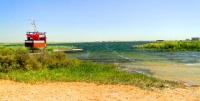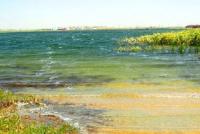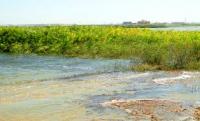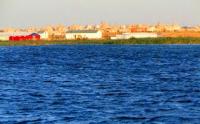You are here
Lakes of Aktobe region.






List of natural attractions of Kazakhstan.
“Nature does not tolerate inaccuracies and does not forgive mistakes”
Emerson Ralph Waldo.
Car tours in Aktobe region.
There are more than 1700 lakes in the region, of which 227 have an area of more than 1 square kilomeres (Filonets, 1974). The territory of the lakes is 0.41%, which is higher than the average for Western Kazakhstan. Lakes for the most part are closed shallow water bodies, occupying saucer-shaped depressions.
Elongated lakes of erosive origin are located in hollows and river valleys. Lakes, like rivers, feed on precipitation. In dry years, their level drops sharply, and some dry out completely, but in wet ones they increase greatly in volume. Freeze-up on most lakes is established in the first half of November.
Melting ice begins in the first half of April. Cleansing from ice occurs in late April. According to long-term data, the average ice thickness can reach 110 cm, and in severe winters up to 150 cm. By the degree of mineralization, most of the lakes are salty.
The distribution of fresh and salt lakes does not obey any zoning. Regardless of the size, the water reserves of the lakes and the salinity of the water fluctuate greatly over the years. The average depths of small lakes are usually 0.7 - 1.2 m, large - up to 4 m.
Fresh lakes are found mainly in the northern regions of the region. As a rule, they are shallow. Some overgrow with reeds, gradually turning into a category of swamp. Fresh lakes are a source of water supply and fishing. The third type of lakes is litter and salt marshes, which are salty mud with a crust of salts on the surface.
The composition of the salts is sulfate in the south and chloride in the north. ccasionally in the south there are lakes with soda salinization. Most lakes are located in the east of the region. The largest are the Kyrgyz-Torgai lakes, with mirror areas of 10 to 45 square kilometers (Zharkol, Baytakkol, Kurdym, etc.).
The lakes of the Kyrgyz-Torgai system are lake-reaches, fed by flood and rainwater. Due to the arid climate, the water level in them is unstable. All lakes are diverse in size and depth; some of them are of fishing importance. The overwhelming majority of lakes of this type are associated with the valley of the Torgay, Yyrgyz, Olkeyek, Telkara rivers.
With abundant groundwater supply, the surface inflow into the lakes is 10 – 40%, and for lakes without ground water – 60 – 90%. The participation of winter precipitation (in the form of snow) in the nutrition of lakes is 10 - 15%. The expenditure part of the annual balance of inland reservoirs is almost entirely determined by losses due to evaporation from the water surface.
According to the basin affiliation, the lakes are divided into three systems:
Lakes of Torgay river system.
Lakes of system of river.
Lakes of Olkeyek river system.
Rivers feed numerous lakes and hollows that form the lake system. The water regime of the lakes depends entirely on the water regime of the rivers. In the valley of the Torgay River, the lakes are deeper and have basins of an elongated or lobed shape.
The largest lakes Baitakkol, Karmakkol, Zhyngyldykol are located on the right-bank floodplain of the river. Lake Baitakol is the largest, its area at full elevation reaches 7400 hectares. Lake Carmackcol is the deepest. Most of the lakes are flowing, their level rises during the flood and with the cessation of runoff of the Torgay river, water flows from the lakes along the channel of the Torgay river to the drainage basin of Shalkarteniz.
Lakes are characterized by their drying out in dry years. About 60% of all lakes are salty. Mineralization in lakes depends on the water content of the year. The lakes located in the river basin of the Kyrgyz Republic differ in relatively small areas and varying depths.
Most lakes are elongated, elongated along the river. The deepest Malaydar. Mineralization of water in the lakes of the Malaydar-Taipakkol group from 2.79 g / dm3 (Lake Tegenkol) to 3.70 g / dm3 (Lake Asaubaykol). Lakes of the Ulkayak system - Kyzylkol, Alakol, Alabugykol.
The largest is Kyzylkol with an area of 3,500 hectares, others are slightly smaller. All lakes are subject to significant fluctuations in the hydrological regime, depending on the water content of the Kyrgyz and Torgai rivers. The size and depth of the lakes depend on the degree of filling them with water.
The phenomenon of drying and fullness is cyclical in nature. The duration of the cycles is 25 - 45 years. The rise in the level of lakes occurs relatively quickly (4 - 8 years), followed by a short period of unstable maximum (1 - 3 years), turning into a slow decline (12 - 20 years or more).
Lakes Shalkar and Old Shalkar are interconnected by channels. The catchment area is 2460 sq. Km. The water in Lake Shalkar is fresh, suitable for drinking after sedimentation and boiling; in Stary Shalkar Lake is brackish. The lakes freeze in early November (ice thickness up to 0.7 m) and open only in late March - early April.
The depth of the lakes is up to 5 m, the bottom is sandy, muddy on the coast. The banks are gentle, 3 to 5 m high, in some places overgrown with reeds. Food mainly due to melt waters of the Kaulzhur River. At the foot of the Mugalzhar chain there are several shallow (1 - 2 m) lakes (Sorkol, Solenoye, Karakol, etc.).
The water in almost all the lakes is salty, in the spring it is slightly desalinated. In summer, the lakes dry up to a large extent. The shores are low, gentle, in some places swampy. On the territory of the region there are shallow lakes, insignificant in area, which, with the onset of summer heat, greatly dry out.
In spring, the water in the lakes is fresh, in the summer - salty. In summer, many lakes dry up.
Irgiz-Turgai lakes.
The height of the Irgiz-Turgai Lakes is from 75 to 100 meters above sea level. IBA is located 70 km east of the village of Kyrgyz, at the southern tip of the Turgay depression, in the lower reaches of the Torgay, Kyrgyz and Olkeyek rivers, and represents an extensive system of numerous lakes of various sizes and salinity, from almost fresh to bitter-salty.
The largest lakes are Kyzylkol, Kolzharma, Zhailau, Zharkol, Bukynkol, Baytakkol, Kogakol, Airkol, Sholakkol, Karmakkol, Maykol, Maydarkol, Aykol. Wetlands are located in the zone of northern deserts and semi-deserts with typical vegetation.
Coastal vegetation is mainly vast reed beds. Irgiz-Turgai Lakes is one of the most significant wetlands of Kazakhstan and Central Asia, which are used by waterfowl mainly during migration and shedding and to a lesser extent for nesting.
There are a number of species listed in the Red Book of Kazakhstan and globally threatened, both nesting and migratory.
In total, 234 species of birds were recorded, including more than 100 types of wetland complex. The lower reaches of Torgaya and Yrgyz are located within the Aral-Ishim section of a powerful migratory stream of waterfowl, the nesting area of which is in Western Siberia.
About 2 - 3 million waterfowl and near-water birds fly here in spring and autumn. Mass accumulations of waterfowl for molting served as one of the main reasons for including this region in the category of sites of international importance. The total number of waterfowl during molting depends on the phase of the flooding cycle and in favorable years can reach several tens or even hundreds of thousands of individuals (up to 250,000 individuals).
In September 2005, more than 156 thousand wetland birds were recorded, in July 2006 - about 42 thousand. These are places of mass molting of a number of species, high numbers on the nesting of mute swan (Cygnus olor, in 2006), great cormorant (Phalacrocorax carbo, 475), coot (Fulica atra, 3115), settlement Platalea leucorodia, 9).
An almost complete range of species bounded by the Eurasian Steppe nests or regularly occurs. The number of globally threatened species with numbers reaching threshold values is 12 species.
Authority:
Natural resources of Aktobe region. Ecoproject LLP. 216 p.
Photos by:
Alexander Petrov.







